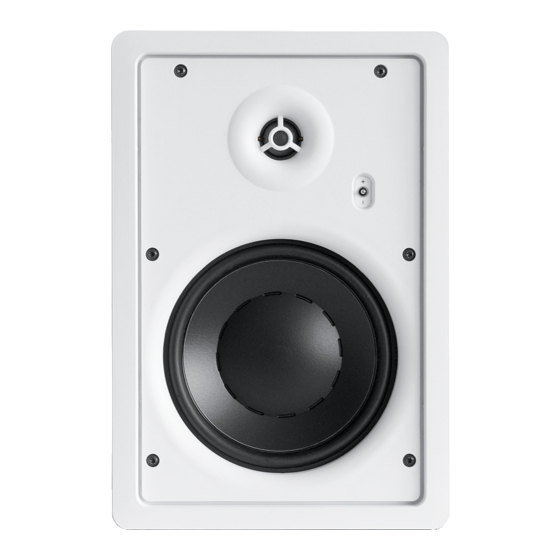Dynaudio IP 24 Manuale d'uso Installazione Prodotto - Pagina 8
Sfoglia online o scarica il pdf Manuale d'uso Installazione Prodotto per Altoparlanti Dynaudio IP 24. Dynaudio IP 24 20. In-wall- and in-ceiling-loudspeaker
Anche per Dynaudio IP 24: Manuale di istruzioni (19 pagine), Prodotti per l'installazione (3 pagine)

Optimizing the sound
The sound quality of any inwall loudspeaker system without a
cabinet enclosure is strongly influenced by the rigidity of the wall
and the damping of the internal wall cavity.
Tip 1: A foam piece is supplied to damp the area behind the
drive units. We recommend the whole section of the wall
cavity to be filled with wadding, such as mineral wool
used for insulation.
Important: You should check that the materials you use meet
the local fire and building regulations.
Tip 2: To obtain a satisfactorily bass response, keep the
area of approx. 1.5 ft (0.5m) around the speaker
clear of wadding (see illustration). If more bass
is required, remove more wadding around the
speaker
Tip 3: To further optimize the sound quality of the speaker,
improve the stiffness of the wall by adding bracing
(inside the wall) around the speaker.
Tip 4: The tweeter level can be adjusted ± 1.5 dB with the
3-position switch placed on the right hand side of the
tweeter.
08 Dynaudio Installation Product
Klangoptimierung
Die Steifigkeit der Wand sowie die Dämpfung des Hohlraums
beeinflussen die Klangqualität eines gehäuselosen
Einbaulautsprechers.
Tipp 1: Die beigelegte Schaumstoffmatte bedämpft den Bereich
direkt hinter dem Lautsprecher. Grundsätzlich empfeh-
len wir, das Wandvolumen mit Dämmstoffen wie
Mineralwolle auszufüllen.
Wichtig: Bitte beachten Sie beim Einsatz der Dämmstoffe
geltende Gesundheits- und Sicherheitsvorschriften.
Tipp 2: Für eine kräftige Basswiedergabe sollte jedoch das
Volumen im Bereich von etwa 0,5 m um den Laut-
sprecher möglichst keine Dämmstoffe enthalten (siehe
Abbildung). Für tiefere Bässe kann der dämmstofffreie
Bereich erweitert werden.
Tipp 3: Zusätzliche Verstrebungen und Verstärkungen im Hohl-
raum stabilisieren die Einbauwand und können so die
Klangqualität erhöhen.
Tipp 4: Mit einem Schalter (rechts neben dem Hochtöner) lässt
sich der Wiedergabepegel der hohen Töne um 1,5 dB
erhöhen oder absenken.
